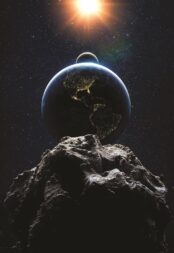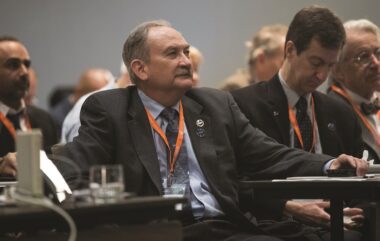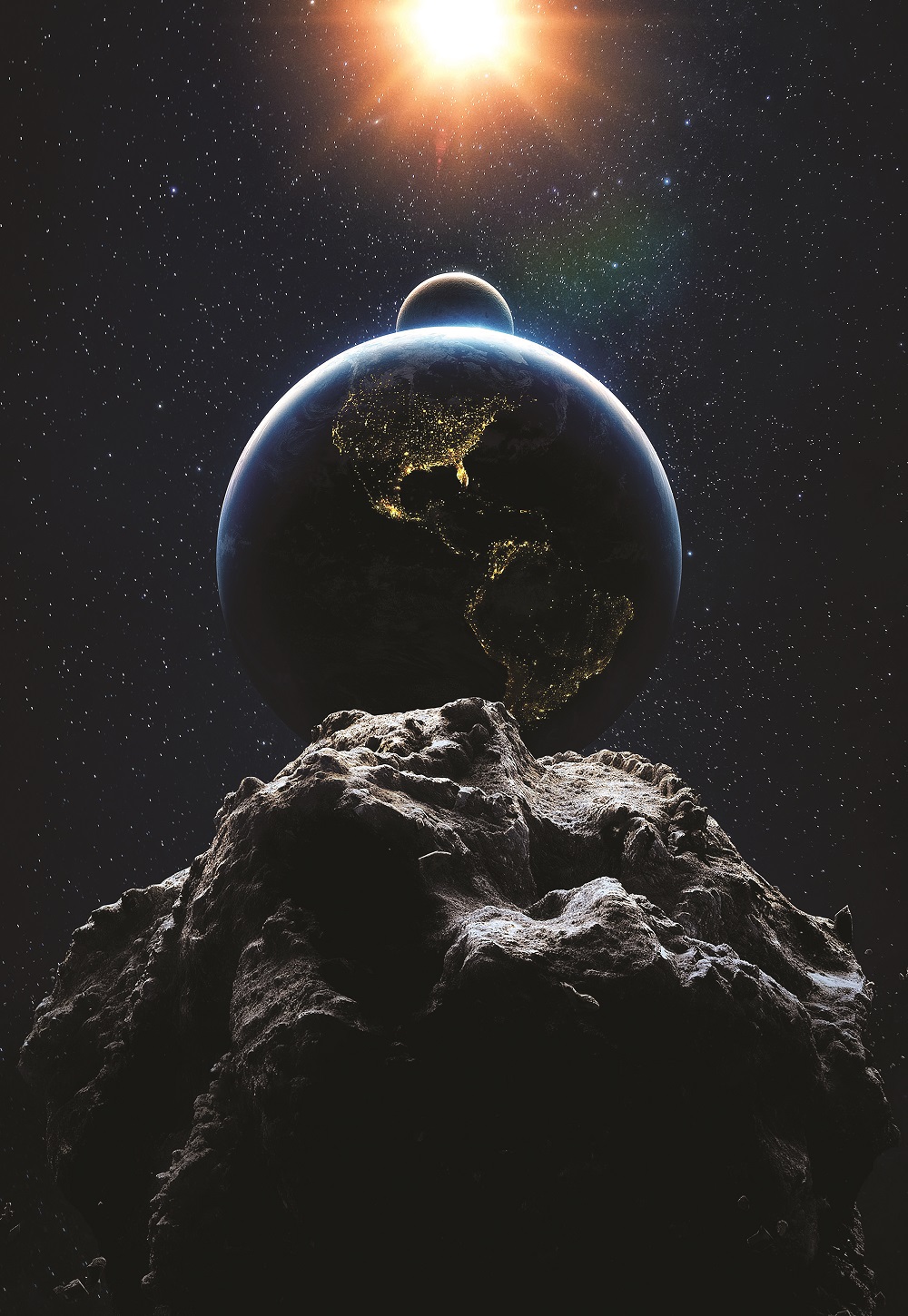“A single strike could reshape our world, and the only thing that can stop it is science.”

Those are the opening lines of “Asteroid Hunters,” an IMAX film narrated by Daisy Ridley of Star Wars fame. If a June 17 screening near the NASA Ames Research Center is any guide, “Asteroid Hunters” achieves its goal of underscoring the threat asteroids pose and the opportunity to deflect a dangerous one headed toward Earth.
At the film’s conclusion, an audience largely comprised of people from NASA Ames and related organizations discussed ongoing efforts to search for near-Earth objects (NEOs), asteroids or comets within about 45 million kilometers of Earth’s orbit. Mainly, they expressed concern for the fate of NASA’s NEO Surveyor space telescope.
NASA’s 2023 budget proposal released in March called for slashing the NEO Surveyor space telescope budget from about $143 million in 2022 to less than $40 million in 2023. The budget plan, which would delay the space telescope’s launch two years to 2028, is opposed by the National Space Society and the Planetary Society.
“We urge the committee to restore funding and augment NASA’s budget to provide at least $170 million to NEO Surveyor in FY 2023,” the space outreach organizations said in a June 16 letter to U.S. House and Senate Appropriations Committees. NEO Surveyor “is the fastest method to satisfy the congressional mandate to detect 90% of NEOs 140 meters and larger. Absent NEO Surveyor, NASA will not achieve the congressional detection mandate for another 30 years.”
Congress directed NASA in 2005 to identify 90 percent of an estimated 25,000 NEOs measuring 140 meters in diameter or larger by the end of 2020 and to analyze ways of diverting threatening ones. Eighteen months past the deadline, fewer than half of those NEOs have been identified.
Experts anticipate swift progress in the coming decade, though, based on the expected contributions of NEO Surveyor and the Rubin Observatory, formerly known as the Large Synoptic Survey Telescope (LSST).
The Rubin Observatory, being built on a mountaintop in Chile, “will observe about 5,000 asteroids in a single image, and hundreds of thousands each night,” said Ed Lu, former NASA astronaut and executive director of the virtual Asteroid Institute at B612. “It will be the big dog, absolutely the most powerful machine ever built for tracking asteroids.”
Telescopes built to track asteroids gather multiple images of the same area every night. The Asteroid Institute and the University of Washington’s Institute for Data Intensive Research in Astrophysics and Cosmology are developing computational tools to detect NEOs in other types of astronomical imagery, as long as they provide five to six views of an area within 15 to 30 days.
An algorithm called Tracklet-less Heliocentric Orbit Recovery, running on Google Cloud, helped astronomers discover 104 main-belt asteroids in a search of the National Optical-Infrared Astronomy Research Laboratory digital archives. An upcoming search of NASA’s Near-Earth Object Wide-field Infrared Survey Explorer data will likely detect thousands.
“We want to apply the technique to the LSST data stream, but we need to practice on these existing datasets,” Lu said.
SPACE-BASED TELESCOPES
Even with powerful computational tools, NASA can’t reach the goal of detecting 90 percent of the 140-meter NEOs anytime soon without a space-based telescope.
“Finding more than 90% of near-Earth asteroids over 140 meters in diameter is a difficult problem because the objects are far away and spread all over the sky, but Rubin and NEO Surveyor together will get the job done,” Amy Mainzer, NEO Surveyor principal investigator and a University of Arizona planetary sciences professor, said by email. “Rubin Observatory uses visible wavelengths and is therefore sensitive to objects with more reflective surfaces, and it searches the night sky. NEO Surveyor operates at thermal infrared wavelengths and is therefore very sensitive to dark objects; it searches the near-Sun regions of the sky, thus allowing it to find objects with the most Earth-like (and therefore potentially hazardous) orbits.”
From its orbit near Sun-Earth Lagrange point 1, NEO Surveyor also will provide data on NEO sizes, “which is important for figuring out which ones are capable of causing severe damage,” Mainzer said. “Given the stakes, and just like monitoring for other types of natural disasters, it’s critical that we have complete coverage.”
A 140-meter asteroid hitting Earth would release hundreds of megatons of energy. “There’s never been an explosion of a nuclear weapon anywhere close to that,” Lu said. (For comparison, the 40- to 60-meter asteroid that flattened an area the size of the Los Angeles basin near Siberia’s Tunguska River in 1908 released an estimated 10 to 15 megatons.)
The planetary sciences decadal survey, published in April by a National Academies committee, supported “the development, timely launch, and subsequent operation of the NEO Surveyor” and Double Asteroid Redirection Test. In September, NASA’s DART spacecraft is scheduled to collide with Dimorphos, a moon orbiting near-Earth asteroid Didymos, demonstrating a technique for deflecting an asteroid’s trajectory.

The timing is not yet clear for NEO Surveyor, which “is extremely important and needs to happen,” said Philip Christensen, an Arizona State University geological sciences professor and co-chair of the planetary sciences decadal survey, Origins, Worlds, and Life: A Decadal Strategy for Planetary Science and Astrobiology 2023-2032.
NASA recommended delaying NEO Surveyor to boost funding for Mars Sample Return and Europa Clipper.
Compared with the $7 billion Mars Sample Return and $5 billion Europa Clipper, NEO Surveyor is a small mission. NASA planned to spend about $811 million on NEO Surveyor from 2022 to 2026 before the President’s budget called for a delay.
“The more you delay a project like this, the more it’s going to cost,” said Lindley Johnson, NASA planetary defense officer.
Plus, NASA will need at least three to five years, and preferably 10, to take action if astronomers discover a large asteroid likely to strike Earth, Johnson said.
“Although a significant impact to the Earth is of course a very rare event, we don’t know when the next one might be, and NEO Surveyor is designed to find out,” Johnson said. “The earlier we find it, the more time we have to react and the more options that are viable to deal with it.”
Congress will ultimately determine NEO Surveyor’s fate. In budget documents released last year, NASA anticipated spending $170 million on the space telescope in 2023. House Appropriators included $94.9 million for NEO Surveyor in the 2023 budget and directed NASA to provide a timeline for launching the telescope before 2028.
Philip Groves, “Asteroid Hunters” writer and producer, hopes the film spurs congressional support of NEO Surveyor and other efforts to detect, assess and, if necessary, divert asteroids. Asteroid Hunters, initially released in 2020 before COVID-19 reduced attendance at IMAX theaters, is now playing in Florida at the NASA Kennedy Space Center visitor complex and in Los Angeles at the California Science Center.
“My hope is to get this in front of as many members of Congress and world leaders as possible,” Groves said. “An asteroid impact is the one natural disaster we can prevent.”
THREATS AND OPPORTUNITIES
Looking ahead, the decadal survey called for “a rapid-response, flyby reconnaissance mission targeted to a challenging NEO of 50 to 100 meters in diameter — which is representative of the population of objects posing the highest probability of a destructive Earth impact.”
Large asteroid strikes are relatively rare.
“In the last century or so, the largest impact that we know about was the Tunguska event,” Johnson said. “An event that really grabs our attention might happen once a century or every other century on average. The situation we’re in right now, though, is we don’t know when the next one is going to be. But we do have the knowledge and the technology to find out.”

NASA also has international partners.
“Although the United States has currently the most significant program looking at this, we are working with a very large team around the world,” Johnson said.
The European Space Agency and Japan Aerospace Exploration Agency have vigorous programs underway. In addition, dozens of countries are part of the International Asteroid Warning Network, a United Nations-endorsed forum focused on helping government agencies analyze potential impacts and mitigate their consequences.
“There are very significant efforts to come to an understanding on the best way to respond to this worldwide hazard,” Johnson said.
Aside from the threat, Lu sees creating a detailed map of the solar system as an opportunity.
“What did all the great powers in the 1500s spend their treasures on? Mapping the world,” Lu said. “We’re on that cusp right now of opening up space, and we will need a map of where things are in the solar system. With 99% of the Tunguska-size asteroids in our solar system currently untracked, we have a very incomplete map right now.”
This article originally appeared in the July 2022 issue of SpaceNews magazine.
